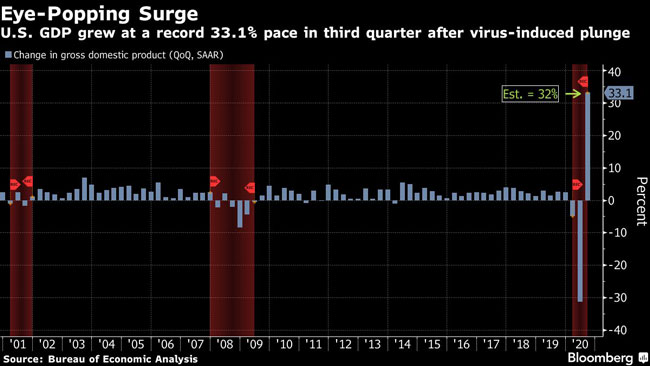Bloomberg News
US Economy Expands at Record 33.1% Pace After COVID Plunge

[Ensure you have all the info you need in these unprecedented times. Subscribe now.]
The U.S. economy bounced back with a record yet temporary surge of growth in the third quarter as businesses reopened and stimulus cash powered consumer spending — reversing much of the collapse stemming from coronavirus lockdowns.
Just as the second-quarter plunge in output was the biggest in seven decades of data, so too was the third-quarter recovery. Gross domestic product grew 7.4%, a quarterly gain that equals an annualized pace of 33.1%, the Commerce Department’s initial estimate showed Oct. 29.
The figure topped economists’ estimates for a 32% increase, which was already well above forecasts three months ago for an 18% gain. Personal spending fueled the surge in growth, climbing an annualized 40.7%, also a record, while business investment and housing also posted strong increases.

While the report makes clear that the economy has found a solid footing for now, analysts caution that growth will be much more modest and choppy in months to come, especially as the spread of the virus gathers pace again and lawmakers remain in an extended deadlock over a new stimulus package.
Moreover, there are still nearly 11 million fewer workers on payrolls than there were before the pandemic hit, and analysts say a full recovery in GDP is at least several quarters away.
Even with the outsize gain, GDP is 3.5% below its pre-pandemic peak, and the virus will keep business and jobs depressed in sectors like travel and restaurants.
With just five days until Election Day, President Donald Trump will likely point to the latest figures as evidence of his ability to guide the American economy through the COVID-19 crisis. His campaign issued a statement saying the report provides “absolute validation of President Trump’s policies.”
It’s unclear, though, how much of an impact the upbeat figures may have on the election, especially given more than 77 million Americans have already cast their vote.
Futures on the S&P 500 rose slightly after economic data Oct. 29. A separate report showed applications for U.S. state unemployment benefits fell more than forecast last week. The yield on 10-year Treasuries was little changed, and the dollar rose.
The third-quarter rise spanned most categories. Residential investment jumped 59.3%, the fastest since 1983, reflecting a recent boom in the housing market, supported by record-low mortgage rates.
Business investment rose 20.3%, though that was driven by equipment, as structures and intellectual property both showed declines.
The rebuilding of inventories added 6.6 percentage points to the quarterly growth pace, and will likely continue to be a prop in the current quarter as companies add to stockpiles that were whittled down during lockdowns.
RELATED: Q2 GDP Drops a Record 32.9%, but Trucking Holding Steady
The pandemic’s impact on Americans’ spending patterns was also clear from the report. Consumer spending typically makes up about two-thirds of GDP.
Goods spending was above pre-pandemic levels, driven by increases in motor vehicles and apparel. Services gained on rebounds in health care and food services and accommodations, but overall outlays remained shy of levels seen at the end of last year.
Meanwhile, net exports subtracted 3.1 percentage points from growth as the trade deficit widened. Government spending was a 0.7 point drag, due to nondefense and state and local outlays.
The third-quarter figures also are in line with generally solid corporate reports during the latest corporate earnings season. So far, about 85% of companies in the S&P 500 have beaten analysts’ earnings estimates, including General Electric Co. and Microsoft Corp.
This is the first estimate of three for the third-quarter figures, and the figure will likely be revised over the next two months as the Bureau of Economic Analysis receives further data.
Want more news? Listen to today's daily briefing:
Subscribe: Apple Podcasts | Spotify | Amazon Alexa | Google Assistant | More




